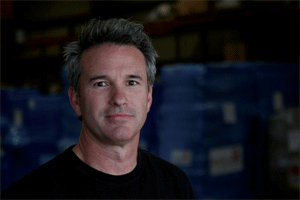
We indulged in a “Pig Pickin’ Party” tradition by drinking bourbon toast in salute to our
dinner at the Sideways 10th Anniversary Winemaker Dinner. Photo by Krista Kennell.
A spirited toast to all things alcoholic! By Leslie Dinaberg
It’s been 10 years since Miles and Jack’s wine-soaked romp through the vineyards of Santa Barbara wine country, and the impact of these memorable Sideways characters—created by by author Rex Pickett and brought to life by director Alexander Payne and a top-notch cast and crew—is still being celebrated throughout the region. This Academy Award-winning movie introduced the world to the incredible Pinot Noirs of Santa Barbara, and has forever changed the wine world’s perception of the bounty that Santa Barbara County has to offer.
The 10th anniversary celebrations for the movie Sideways kicked off last weekend with a wonderful party at Clenenden Ranch. Hosted by restaurateur and winemaker Frank Ostini (The Hitching Post II Restaurant & Winery) and winemaker Jim Clendenen (Au Bon Climat), this “Pig Pickin’ Party” was quite the shindig, featuring director Payne and movie star Paul Giamatti, an impressive roster of local winemakers, as well as special guests Jim n’ Nick’s BBQ of Birmingham, Alabama.

Enjoying the festivities (L-R), Gray Hartley of Hartley Ostini Hitching Post wines; Sideways star Paul Giamatti, Frank Ostini of Hartley Ostini Hitching Post Wine; Sideways director Alexander Payne, Sideways producer Michael London and Jim Clenenden of Au Bon Climat wines. Photo by Krista Kennell.
As you might imagine, Ostini and Clendenen served some amazing hand-selected Sideways original era 2004, 2005 and 2006 wines from Au Bon Climat, Hitching Post and Clendenen Family Vineyards—and other vintners also brought along some specially selected bottles to pair with Jim ‘n Nick’s southern-style barbecue feast, which included flying in their own heritage breed pig that was then slow roasted overnight for the party.
In addition to the party at the ranch, which I was fortunate to be able to attend, the following evening the Santa Barbara Vintners Foundation continued the festivities by celebrating the Sideways milestone anniversary partnering with Direct Relief (a 14-year partnership) on the Santa Barbara Wine Auction, a biennial gala event that since 2000 has raised $3 million in support of Direct Relief’s mission to provide medical aid and relief to people facing emergency situations around the globe.
“At this year’s auction, through the generosity of local vintners and Direct Relief supporters, we were able to raise $1 million,” reports Foundation president Jennifer Williamson Doré. “A significant component of that number was contributed by bidders desiring the chance to come together to celebrate the anniversary of the release of Sideways at a 10 Year reunion dinner, generously donated by Frank Ostini and the Hitching Post II and Jim Clendenen of Au Bon Climat Winery.” To Jack and Miles we say, “Well done!”

Sideways star Paul Giamatti and Frank Ostini of Hartley Ostini Hitching Post wine skyped with Giamatti’s co-star Virginia Madsen at the benefit event for Direct Relief International. Photo by Krista Kennell.
In addition to the gala Santa Barbara Wine Auction, the Santa Barbara Vintners Foundation raises funds annually through silent auctions at both the Vintners Festival and Celebration of Harvest in support of local nonprofit organizations including Santa Ynez Valley People Helping People, sponsorship of Vino de Sueños annual event, FoodBank of Santa Barbara County, Santa Barbara Vintners Foundation Scholarship Program, Annual Scholarships to qualifying high school seniors in northern Santa Barbara County and Annual Scholarships to qualifying students in the Allan Hancock College Enology and Viticulture program.
In what’s sure to be one of many more Sideways celebrations to come, the Solvang Conference & Visitors Bureau is holding a Merlot Taste-Off event on September 13 to pay homage to wine variety made famous in the Oscar-winning film. As may recall, in the movie the character of Miles has the memorable line: “If anyone orders merlot, I’m leaving. I am not drinking any (expletive) merlot!”
Tracy Farhad, executive director of the Solvang CVB retorts, “No more denigrating merlot! Come taste these marvelous wines for yourself.”
Participating wineries include Baehner Fournier, Buttonwood, Carivintas, Core, Dascomb, Happy Canyon Vineyard, J. Ludlow, Lions Peak, Lucas & Lewellen, Point Concepcion, Sagebrush Annies, Sevtap and Sunstone. Local restaurants will provide gourmet appetizers.
The tasting will take place in the garden courtyard of the Solvang Festival Theatre (420 Second St.), and proceeds will benefit the nonprofit theater. For information and tickets call 805/688-6144 or visit SolvangUSA.com.
Stay tuned, there are many more Sideways celebrations to come.
Cheers!
Click here for more cocktail corner columns.
When she’s not busy working as the editor of Santa Barbara SEASONS, Cocktail Corner author Leslie Dinaberg writes magazine articles, newspaper columns and grocery lists. When it comes to cocktails, Leslie considers herself a “goal-oriented drinker.”

Jim Clenenden greets guests at his ranch in Los Alamos. Photo by Krista Kennell.

Winemakers enjoyed a special “Pig Pickin’ Party” bourbon toast in salute to the pig at the Sideways 10th Anniversary Winemaker Dinner. Photo by Krista Kennell.

Just a peek at the fabulous fixings at the Sideways 10th Anniversary Winemaker Dinner. Photo by Krista Kennell.

A view worth turning sideways to see, at Clenenden Ranch in Los Alamos. Photo by Leslie Dinaberg.
Originally published in Santa Barbara SEASONS on August 8, 2014.


